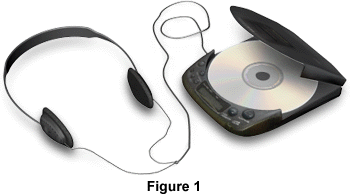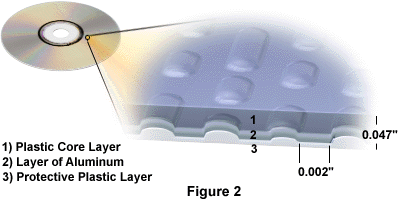
History of the Compact Disc
Starting in the mid 1980's, compact discs (CD) began to take over both the audio and computer program market. Much of this can be attributed to a general acceptance of certain specifications regarding compact discs, known as the "Color Books." Originally designed and developed by both Sony and Phillips, the concept of the Color Books was patented and standards were developed. These are a collection of five books that describe the specifications and standards CD technology follows. This led eventually to the current audio CD technology (Figure 1).

The first book, written in 1980, was named the "Red Book" and outlined the specifications regarding CD Digital Audio. This was the common CD used in stereo systems, and was capable of holding up to 99 tracks, for a total of roughly 74 minutes of audio information.
The second book was written in 1983 and is known as the "Yellow Book", comprising the basis of the Compact Disc - Read Only Memory (CD-ROM). This became the standard for computer-based compact discs, and meant that any computer system that had a CD-ROM drive, could read this format. It is capable of holding around 650 million bytes of data. CD-R's were developed under the same standards, but the actual CDs were comprised of different material. While the generic CD-ROM discs uses aluminum in their construction, the CD-R discs uses gold, which makes color a distinguishing feature.
The third book, known as the "Green Book," covered CD-Interactive technology, is used to synchronize both audio and data tracks on a CD-ROM in order to provide things such as full motion video combined with interactivity. Published in 1986, Phillips Interactive primarily marketed this technology.
The fourth, the "Orange Book", is merely an outline for the coming generation of writable CD technology, primarily CD-E. (Compact Disc - Erasable) This is meant to replace, or be used in the same matter as floppy discs, only providing a much larger medium to store data. The technology is available today, but know otherwise as CD-RW. (Compact Disc - ReWritable) Much like a floppy disc or hard drive, data can be written and rewritten to these discs, allowing for a very large yet portable medium of data storage.
The last book known as the "White Book," is a plan for the future of compact disc technology. It outlines what is known as video compact discs, and contains the standard of data compression that is used to display large amounts of audio and video on a home computer. This concept more or less morphed into what is now known as DVD (Digital Video Drives,) a technology produced primarily by Sony, Phillips and Toshiba. While not compatible with the standard CD-ROM drives used in computers, it did achieve what the White Book had outlined for the future.

While an overview of how compact disc technology developed and became so popular is presented, it fails to explain how the technology works. There are, however, relatively simple processes accounting for how a compact disc is read and how the CD-ROM drive translates that into data your computer can understand. First is the construction of the compact disc. It is built from a layer of polycarbonate plastic, covered in a color-dyed layer of aluminum, and followed by a protective layer of lacquer. Figure 2 shows a cross section of a compact disc, illustrating the different layers and providing a general idea behind its construction.
When a compact disc is written to, tiny rivets are made in the surface of the disc called stripes or pits. The areas between these pits are called lands, which together make up a pattern where data is written. From there, a CD-ROM drive uses a read head to interpret these patterns, which is done by focusing a laser beam on the surface of the disc. While the CD is spinning, this laser comes in contact with the lands and pits. If the laser comes in contact with a pit, the light is reflected off in all directions. However, if the light comes in contact with a land, it reflects back into the read head, triggering an electric impulse. Figure 3 illustrates the difference between a land and a pit, and how the light is reflected in each situation.

A pattern is developed from these electric impulses, and the CD-ROM drive returns this pattern to the computer as a string of 1s and 0s. This binary or digital data is in turn interpreted by the software controlling the CD-ROM drive, and then translated into something the computer can use, be it an executable program, an image, or a sound file.
BACK TO ELECTRICITY AND MAGNETISM HOME